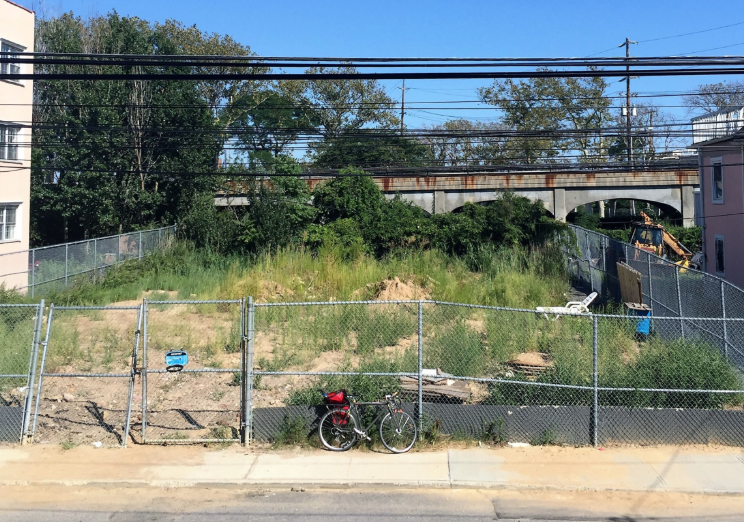At the beginning of June 2018, 596 Acres sent an email update about dialing back staff. We are at a pivotal moment and want to share some lessons learned and celebratory moments, and also acknowledge some points of tension that led here.
How 596 Acres Began
596 Acres started in 2011 as an idea, sparked by discontent over mismanagement of public land in north Bedford Stuyvesant. The organization’s name describes a state of municipal neglect — our earliest research found five hundred ninety-six acres of vacant city-owned property — and embodies a tactical approach to changing land use for NYC neighborhoods.
The all-volunteer team deployed 596’s first online map of Brooklyn on August 21, 2011, also posting physical signs at vacant lots. One year later, they expanded the map to include Queens and Manhattan. More volunteers came on board, spending weeks doing direct outreach to organizations in Rockaway, the Lower East Side, and Harlem, in neighborhoods where vacant city-owned land is highly concentrated.
In early 2013, the founders (Eric Brelsford and Paula Segal) recruited a few close friends to join them to create an initial Board of Directors for a corporation that might grow. They incorporated as a Not for Profit under New York State law and opened a bank account.
How Organizational Change Expanded Capacity and Created Challenges
In March 2013, the Knight Foundation agreed to fund an improvement of the 596 Acres online tool and the development of a sibling tool for New Orleans. In order to accept that grant funding, however, we needed better infrastructure, like the ability to pay staff and consultants. The Board of Directors agreed that 596 Acres should become a Partner Project of the Fund for the City of New York. Doing so gave us new capacity to employ a staff and provide benefits like public interest loan repayment, and also expanded our ability to accept grants from foundations. The Fund required the team to close the independent bank account.
Over the five years that followed, nineteen people were paid for their labor, some as consultants and some as full employees who received salaries and benefits.

The Board continued to volunteer their time. Together with the staff and an Advisory Committee (AC), they fundraised to pay for the costs associated with dedicated labor. The Fund received a small fee for processing payments and maintaining key services like health insurance and a human resources staff. For the next three years, the Board periodically evaluated 596’s relationship with the Fund and the programs run by our staff and consultants (596 Acres itself never employed any staff or consultants directly; everyone worked officially for the Fund for the City of New York).

The Advisory Committee was made up of people from projects that 596 had supported as well as trusted allies from other organizations. One of the first questions the committee grappled with after forming in 2013 was whether to release data for Staten Island and the Bronx — boroughs that 596 Acres did not have the infrastructure to reach directly, the way we had in Queens, Manhattan, and Brooklyn. The AC counseled that leaving those boroughs out of the project would be wrong, and committed to doing what was possible to help 596 reach the communities that lived there.
In 2016, the Board decided to change its relationship to the organization, effectively disbanding in order to give the staff the power to execute the organization’s mission. That included managing the relationship with the Fund, running 596 Acres programs, and making financial decisions. It also involved closing the door to staff positions for the founders. There was a reserve of over $250,000 at the time of this transition.
A lot of factors motivated this decision; particularly significant was the lack of representation of communities of color that had persisted on the Board. Board members, including the founders, had made repeated attempts to bring people from the communities of color we were working with onto the 596 Board of Directors. Repeatedly, however, those invited to volunteer to serve on the governing board chose instead to spend their limited capacity working directly with their own local communities, rather than stewarding infrastructure designed to support geographically diffuse efforts. Equitable inclusivity was not manifesting, so it was time for a different approach.
Paula encouraged the staff to join the non-profit democracy network and adopt a non-hierarchical internal structure, similar to a worker cooperative. The intention was to align the organization’s daily practices with larger principles of liberation. However, the emerging structure had serious weaknesses. For one thing, it did not support the staff in managing internal conflicts. Power differentials emerged between new staff members and those with longer tenures, and were not dealt with. Moreover, the role of race in the workplace went unaddressed — the ways that racialized power dynamics at 596 Acres could reflect larger societal patterns of violence, oppression, and privilege. These challenges grew and compounded each other, and the organization’s aspirationally non-hierarchical structure did not allow its small staff to overcome them.
Meanwhile, having three employees receiving salaries and benefits required more funding than ever before. The reserve ran out, and additional money raised was not enough to refill the coffers. By the end of May 2018, funds had run dry. 596 Acres ceased to be a Partner Project of the Fund for the City of New York.
What 596 Acres Accomplished
We are both proud of our shared accomplishments and crestfallen at the shortcomings of this seven-year endeavor. While we are not exactly sure what, if anything, the future holds for 596 Acres, we can definitely share the history of our advocacy campaign:
-
Over forty (40!) new community controlled spaces where vacant lots used to be,
-
Continued organizing by dozens of groups around the City that are in touch with the appropriate decision makers,
-
Maps for Philadelphia, Los Angeles, and New Orleans using the Living Lots® platform, our online tool for mapping and organizing around vacant lots, to support their work,
-
The first ever Vacant Acres Symposium, bringing together knowledgeable and passionate urban vacant land advocates to discuss land access, strategies for land tenure protection, racial and economic justice issues in access to vacant urban land, and the wide variety of urban contexts experienced by our participants from cities around the world,
-
Successful advocacy for open access to MAP PLUTO, a source of important government-produced geodata on NYC land that was previously only made available by the city for $3000 per year,
-
Inclusion of a Community Land Trust as an ultimate disposition for the property in planning documents for the Edgemere Urban Renewal Area Plan,
-
An interactive and accessible lot-by-lot map of the history of Urban Renewal Planning in NYC, 1949 to present, at urbanreviewer.org, posted in 2015 and updated to reflect the latest Urban Renewal Area Plan created for the Downtown Far Rockaway Plan in 2017 (the City followed our lead legislated its own version in 2017!),
-
A NYC Parks inventory expanded by 36 community managed spaces created by preserving “interim” gardens that NYC HPD had planned to sell for $1,
-
An accessible database of deed restrictions held by the City of New York for public benefit, to be populated going back to 1966 by the Department of Citywide Administrative Services,
-
A tool exposing the City’s practice of selling land for $1 at onedollarlots.org (site no longer working),
-
And NYCommons.org, based on the the Living Lots® source code, which includes public vacant lots, libraries, post offices, waterfronts, unused NYC Parks buildings and public housing campuses, which partners continue to use.
Through these accomplishments, we have moved the needle on how municipalities, and NYC in particular, view and deal with city-owned property. In the midst of a decades-long neoliberal movement to shrink and constrict governmental services and functions, 596’s tactical interventions and organizing worked together to effectively expand municipal services, shorten agency response times, and dramatically change the role and function of local governance through community input and interaction with public land.
The volunteer team will continue to support organizers as we are able. Stay tuned for more opportunities to plug in and keep organizing in your neighborhoods.
How We Can Learn from Our Shortcomings
Here are some other themes that have been running through our team conversations in the last few months. We hope these will serve as starting points of conversations in your lives:
-
White leadership perpetuating white supremacy.
-
The power of anxiety and duress to trigger ugly manifestations of socialized power and privilege.
-
Use of colonizing language in our public signage campaigns (“This Land is Our Land” and “There is Land If You Want It” have both been used as part of campaigns to displace native people from the North American continent).
-
The imperative for robust internal decision-making structures that 596 Acres recognized were needed by groups organizing in our neighborhoods.
-
The friction between non-hierarchical leadership and the structure of employment law, which is premised on there being a power differential between labor and management in the workplace.
-
The inherent non-alignment between a decentralized movement and the traditional centralized non-profit institution accountable to its funders and donors.
-
The challenge of imbuing any organizational structure with anti-oppression principles.
Onwards!
596
P.S. 596acres.org, nycommons.org and livinglotsnyc.org will continue to exist as digital resources for communities to access the information and tools we developed over the years and to organize online. Paula is paying the costs associated with hosting those herself ($150 per year), as well as the cost of maintaining the mailing list on MailChimp ($54 per month) and the phone number ($228 per year). Contributions or suggestions for how to reduce these costs of $1,026 per year welcome: paulaznyc@gmail.com on PayPal or @Paula-Segal-1 on Venmo.
P.P.S. Good news this week! Two Rockaway sites that 596 Acres has been supporting getting transferred to NYC Parks for stewardship as community gardens since Superstorm Sandy are in the NYC Parks inventory as of last week. Welcome Edgemere Coalition Community Garden on Beach 43rd and Beach 84th Street Community Garden (photo above) to the 596 Acres network. In addition to the transfer, these long neglected City-owned sites will be getting sidewalks, grading and fencing improvements. Click the links for details of the campaigns and to get organizer contact information to plug in.






